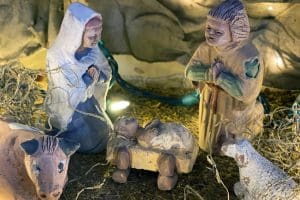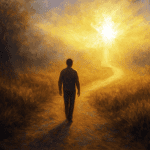Abstract
Lehi taught that if Adam and Eve had not transgressed, “they would have had no children” (2 Nephi 2:13). This claim is plausible when viewed in the context of various extrabiblical traditions.
According to the book of Genesis, “God created man in his own image, in the image of God created he him; male and female created he them. And God blessed them, and God said unto them, Be fruitful, and multiply, and replenish the earth” (Genesis 1:27–28). Because this commandment to procreate was given in a pre-Fall setting, the Christian world has largely held to the view that Adam and Eve could have had children in the Garden of Eden. The primary rationale is that God would never have given them a commandment that they could not fulfill without first transgressing another commandment. This view was established by prominent theologians in the Middle Ages, such as Saint Augustine and Thomas Aquinas, and has held sway ever since.1
There are, however, several curious details from the biblical account that hint that Adam and Eve may not have been able to procreate prior to the Fall after all. The first clue comes from the fact that the scriptural record never states that Adam and Eve had any children in the Garden of Eden.2 Another clue derives from their apparent state of innocence, for only after they partook of the fruit were their “eyes … opened, and they knew that they were naked; and they sewed fig leaves together, and made themselves aprons” (Genesis 3:7).3 Finally, it is interesting that the sorrow of childbearing is only emphasized after the Fall. Speaking to Eve, the Lord declared, “I will greatly multiply thy sorrow and thy conception; in sorrow thou shalt bring forth children” (Genesis 3:16).4
These details, however, are not conclusive. The text is ambiguous, and for centuries leading up to Joseph Smith’s day Christian thinkers and theologians predominantly believed that Adam and Eve had the capacity to procreate before their Fall from Eden.
The Book of Mormon View
With this context in mind, it is notable that the Book of Mormon takes the opposite view. When giving his final blessing on his son Jacob, Lehi declared:
And now, behold, if Adam had not transgressed he would not have fallen, but he would have remained in the garden of Eden. And all things which were created must have remained in the same state in which they were after they were created; and they must have remained forever, and had no end. And they would have had no children; wherefore they would have remained in a state of innocence, having no joy, for they knew no misery; doing no good, for they knew no sin. (2 Nephi 2:22–23)
Lehi never explained why Adam and Eve could not have had children, but it is interesting that the statement is closely followed by a comment on Adam and Eve’s innocence before their transgression.5
Support from Extrabiblical Sources
As in many other instances, this unique detail in Joseph Smith’s revelations finds varying degrees of support from extrabiblical sources. One line of evidence comes from rabbinic traditions that made a distinction between beings from the upper realm (heaven) and the lower realm (earth). In this framework, angelic creatures from the upper or supernal realms were viewed as not being able to procreate, while animals from the lower regions were able to propagate their species. Adam and Eve were seen as having a unique blending of these traits.
In Bereshit Rabbah, a rabbi describes mankind as being created from both heavenly and earthly elements. From the lower realm, man “eats and drinks as does an animal, procreates as does an animal, defecates as does an animal, and dies as does an animal. From the supernal realm: He stands as do the ministering angels, speaks as do the ministering angels, has intelligence as do the ministering angels, and sees as do the ministering angels.”6 A different rabbi from this source explains, “The supernal beings were created in the [divine] image and likeness, but do not procreate, while the earthly beings [that have been created up to now] procreate, but were not created in the [divine] image and likeness. The Holy One blessed be He said: ‘I will create him [Adam] in the [divine] image and likeness, [a trait] from the supernal realm, but he will procreate, [a trait] from the earthly realm.”7 These ideas are broadly in line with Doctrine and Covenants 132:16–17, which states that angels “cannot be enlarged, but remain separately and singly.”8
While these sources are silent as to how Adam and Eve specifically attained the qualities associated with the lower realm (including procreation), others attribute the acquisition of animal-like traits as being directly related to their partaking of the forbidden fruit. The early Church Father Gregory of Nyssa wrote, “It is clear that the life before the transgression was a kind of angelic life.” However, upon noting that angels cannot procreate as mankind, Gregory pointed out that after the transgression in the Garden of Eden, mankind “truly was made like the beasts, who received in his nature the present mode of transient generation, on account of his inclination to material things.”9 Another text, called The Words of Adam and Seth, declares that Adam, “not having observed the commandments, and having been stripped of the divine light, and having been thrown outside the Garden, became an equal of the dumb beasts.”10
The theme of Adam and Eve losing the light and glory of Eden turns up in many other texts as well. A Zohar commentary called Midrash Ha-neʿelam to Shir ha-Shirim explains:
And when the Holy One, blessed be He, created Adam the Protoplast, He introduced him into the Garden of Eden (clothed) in a garment of glory that was consubstantial with the light of the Garden of Eden … [but he sinned] and those garments flew off of him, and the luminous soul which opened a window to what was above departed from him, and he was left stripped of all (these things).”11
Another Zohar text, known as Terumah, claims that “the perfection below [i.e., in the mortal world] was lacking since it had been lost through the transgression of Adam the Protoplast. He (i.e., Adam) descended below and hid himself among the trees of the garden. There he was stripped of all the aspects of the garden.”12 It may be significant that both of these narratives relate directly to the crucial themes of innocence and clothing in the Genesis account, where Adam and Eve were found naked and God provided coats of skins for them after their transgression (Genesis 3:21).
Within such sources, Adam and Eve being clothed in the Garden’s light appears to be a metaphor to explain the spiritual qualities of their bodies before the Fall. This understanding is supported by the fact that each of these accounts uses the departure of this light from Adam to help explain Enoch’s later transformation into an angelic being. Midrash Ha-neʿelam to Shir ha-Shirim explains that when “Enoch came, that supernal light—the holy soul—descended into him, and Enoch was invested with the supernal dignity which had left Adam.”13 Terumah likewise reports that one day Enoch “went inside the Garden of Eden, and [the angels who dwelled there] showed him the secrets of the garden …. Afterwards he cloaked himself (with) that light inside that garment.”14 In other words, Enoch’s physical body became filled with the same angelic light associated with the Garden that had once imbued Adam and Eve before they transgressed.15
According to Chesed LeAvraham, when the Messiah comes in the end times, resurrected beings will gain bodies that are similar to the one that Adam had before he sinned: “On that day, the dead in the Land of Israel will return at the time of their revival in a new spiritual form. Similarly, the seven thousand who are alive, all will be in a new spiritual form, akin to the form of Adam before sin.”16 While this doctrine doesn’t align with Restoration scripture (which treats post-mortal resurrected bodies as being different from pre-mortal unembodied spirits), it still illustrates how some Jewish traditions viewed Adam’s body as undergoing a change after he transgressed.
One striking conclusion from these traditions is that the Garden of Eden itself may not have been entirely grounded in the physical world. At least on one level, it was apparently believed to be an otherworldly realm of light and glory, where angels dwelled and righteous men like Enoch could one day return.17 In 2 Enoch we read that after God created the Garden of Eden and placed Adam therein, God then “created for him an open heaven, so that he might look upon the angels, singing the triumphal song. And the light which is never darkened was perpetually in paradise.”18
A Jewish work known as Shulchan Shel Arba makes a similar comment. The “world of souls,” it explains, “is what is called ‘Garden of Eden’ (gan aden) among the sages, and they called it this by way of an allegory, using the example of how the body takes delight (mitaden) in a garden.”19 A particularly interesting account, which describes the Garden as a place where premortal spirits dwell, can be seen in Sefer Mishkan ha-ʿEdut:
Before Adam the Protoplast had been introduced there, the Garden was not empty. And not only were the plants and the delightful things there, also there were all the souls destined to exist in the world, each of them endowed with the likeness, form, and appearance which they would have afterwards. Truly they have been (there) since the day they came into existence, and they still by a miracle remain there at present.20
Especially when viewed through the lens of Restoration scripture, the Eden narrative appears to be highly symbolic. Adam and Eve’s choice to partake of the forbidden fruit seems intended to symbolize the choice that all of mankind would make to leave the premortal realm and enter into the lone and dreary world of mortality. Thus, while still in the Garden, Adam and Eve may have had angelic bodies of light, rather than physical bodies of flesh and blood. And, in such a state, they very well may not have had the physical capacity to procreate before their transgression, just as Lehi had claimed.21
It is also possible that they had bodies of flesh and blood (or at least flesh and bones) but that they were different in some fundamental way compared to typical human bodies. Precedent for this idea can be seen in the physical traits of translated beings such as the three Nephites, whom Mormon described as not being susceptible to physical pain or death (3 Nephi 28:36–40) and who were “as the angels of God” (3 Nephi 28:30).
Whatever the case may be, it should be emphasized this matter has never been formally settled by revelation. Even though these explanations are plausible based on the available scriptural evidence, and even though they are enticing when viewed in light of various extrabiblical sources, they must remain tentative without further revelatory confirmation.
Conclusion
If Joseph Smith had simply made up the Book of Mormon, he went out on a limb when declaring that Adam and Eve “would have had no children” had they not transgressed (2 Nephi 2:13). While the account in Genesis suggests that a mystery related to procreation may indeed be present in these passages, Lehi’s bold claim was antithetical to centuries of mainstream Christian thinking and biblical interpretation.
It is therefore quite fascinating that various lines of evidence from ancient and medieval sources can be found in support of Lehi’s statements. At least the following related points can be derived from these texts: (1) angelic beings, unlike creatures in the mortal realm, cannot procreate, (2) the Garden of Eden was a place where angels or spiritual beings dwelled, (3) Adam and Eve had glorious angel-like bodies while in the Garden of Eden, and (4) when Adam and Eve sinned, they lost their angelic glory and their bodies became more like the beasts of the earth, which had the ability to procreate. While such sources do not definitively prove the truth of Lehi’s assertion, they render it as surprisingly plausible and very much aligned with Jewish thinking and early traditions about the Garden story.22
Further Reading
Andrew Skinner, “The Tree of Life in the Hebrew Bible and Later Jewish Thought,” in The Tree of Life: From Eden to Eternity, ed. John W. Welch and Donald W. Parry (Deseret Book, 2011), 25–54.
Stephen D. Ricks, “Adam’s Fall in the Book of Mormon, Second Temple Judaism, and Early Christianity,” in The Disciple as Scholar: Essays on Scripture and the Ancient World in Honor of Richard Lloyd Anderson, ed. Stephen D. Ricks, Donald W. Parry, and Andrew Hedges (FARMS, 2000), 595–606.
Bruce M. Pritchett Jr., “Lehi’s Theology of the Fall in Its Preexilic/Exilic Context,” Journal of Book of Mormon Studies 3, no. 2 (1994): 49–83.
Relevant Scriptures
Bible
Book of Mormon
Footnotes
1. See Saint Augustine, The City of God, trans. John Healey, vol. 2 (John Grant, 1909), 46–52; Thomas Aquinas, Summa Theologica, Part I, trans. Fathers of the English Dominican Province (Burns, Oates & Washbourne, 1912–38), 344–346.
2. Not too much should be made of this detail, since the account doesn’t provide a timeline for how long Adam and Eve were in Eden before their transgression, but it is a relevant data point, nevertheless.
3. One might reasonably wonder how they could be expected to procreate if they weren’t aware of their nakedness (as such a condition suggests a lack of knowledge about the function or purpose of their sexual organs). However, their nakedness also seems thematically connected to the concepts of justice and judgment, in that they couldn’t hide their sin. Thus, precisely what one is to make of this textual detail isn’t fully clear based on the text alone.
4. One could argue, however, that childbearing could have transpired before the Fall, but that it simply would have lacked any element of sorrow or anguish.
5. One could possibly interpret these passages as explaining what would have happened if Eve had partaken of the fruit but Adam had refused to do so. Under that reading, the inability to have children may have resulted from Adam remaining in the Garden while Eve was cast out, causing them to be eternally separated. While this conclusion isn’t impossible, the specific language of the text argues against it. The use of the plural “they” is particularly significant: “if Adam had not transgressed … they would have remained in a state of innocence, having no joy, for they knew no misery; doing no good, for they knew no sin” (2 Nephi 2:22–23). If the text were only speaking of Adam not transgressing, this statement wouldn’t make sense, since it goes on to describe how both Adam and Eve would have remained innocent and ignorant of good and evil had the transgression not occurred. It therefore seems most likely that when the Lehi spoke of Adam partaking of the fruit, he was speaking metonymically (where Adam refers jointly to both Adam and Eve). Several other scriptural passages use the name Adam in this way, as a substitute for both Adam and Eve or for all of mankind. See, for example, Romans 5:14; 1 Corinthians 15:22; 2 Nephi 9:21; Mosiah 3:11; Mormon 9:12; Moses 1:34. See also Royal Skousen, Analysis of Textual Variants of the Book of Mormon, Part One: 1 Nephi–2 Nephi 1 (FARMS, 2014), 505–506.
6. See Bereshit Rabbah 8:11, online at sefaria.org.
7. Bereshit Rabbah 14:3, online at sefaria.org; bracketed text in the original. See also Ramban on Leviticus 17:7. It should be noted that a paradox seems to be at play when it comes to the ability to create posterity. On one level, the basic instinct to procreate in human bodies can easily devolve into unsanctioned lust and can therefore be viewed as a primarily negative animal-like trait. On the other hand, the capacity to create human bodies may be viewed as a unique gift from above (as seen in D&C 132:16–17). Thus, while this gift may transcend the realm of angels, whether it makes one more animal-like or more god-like seems to depend on how it is used.
8. Although this statement pertains to a post-mortal context, it may reasonably apply to pre-mortal life as well. A fundamental tenant of Latter-day Saint theology is that mankind came to earth to receive physical bodies, which have capacities or functions not afforded to unembodied spirits.
9. Gregory of Nyssa, “On the Making of Man,” in Nicene and Post-Nicene Fathers, Second Series, vol. 5: Gregory of Nyssa: Dogmatic Treatises, Select Writings and Letters, ed. Philip Schaff and Henry Wace (Christian Literature Publishing Co., 1893), 755–756.
10. Michael E. Stone, Armenian Apocrypha Relating to the Patriarchs and Prophets (Jerusalem, 1982), 12–13; cited in Moshe Idel, “Enoch is Metatron,” Immanuel 24, no. 25 (1990): 229. This description may be echoed by the phrase “natural man” found in canonized scripture (Mosiah 3:19; 1 Corinthians 2:14). As described in Moses 5:13, when men began to follow Satan, they became “carnal, sensual, and devilish.”
11. Zohar Ḥadash, Midrash Ha-neʿelam to Shir ha-Shirim fol. 69a–b (ed. Margaliot); as cited in John C. Reeves and Annette Yoshiko Reed, Enoch from Antiquity to the Middle Ages (Oxford University Press, 2018), 299.
12. Zohar Ḥadash, Terumah fol. 42d (ed. Margaliot); as cited in Reeves and Reed, Enoch from Antiquity to the Middle Ages, 175.
13. Zohar Ḥadash, Midrash Ha-neʿelam to Shir ha-Shirim fol. 69a–b (ed. Margaliot); as cited in Reeves and Reed, Enoch from Antiquity to the Middle Ages, 299.
14. Zohar Ḥadash, Terumah fol. 42d (ed. Margaliot); as cited in Reeves and Reed, Enoch from Antiquity to the Middle Ages, 175.
15. See Scripture Central, “Book of Moses Evidence: Enoch Clothed with Glory,” Evidence 500 (June 25, 2025).
16. See Chesed LeAvraham, Even Shetiya, Maayan 3 22:2, online at sefaria.org.
17. See Tractate Derekh Eretz Zuta 1:18: “There were nine who entered the Garden of Eden alive, viz.: Enoch the son of Yered, Elijah, the Messiah, Eliezer the servant of Abraham, Hiram, king of Tyre, Ebed-melech the Cushite, Jabeẓ the son of R. Judah the Prince, Bithiah the daughter of Pharaoh, and Seraḥ the daughter of Asher. Some say: Also R. Joshua b. Levi.” A similar description of a spiritual return to Eden, facilitated by a messianic priest figure, can be seen in H. C. Kee, “Testament of the Twelve Patriarchs,” in The Old Testament Pseudepigrapha, 2 vols., ed. James H. Charlesworth (Doubleday, 1983–1985), 1:795: “And [the Lord] shall open the gates of paradise; he shall remove the sword that has threatened since Adam, and he will grant to the saints to eat of the tree of life.”
18. Translation by F. I. Anderson, “2 (Slavonic Apocalypse of) Enoch,” in The Old Testament Pseudepigrapha, 1:152.
19. Shulchan Shel Arba 4:16, online at sefaria.org.
20. R. Moses de León, Sefer Mishkan ha-ʿEdut (ed. Bar-Asher); as cited in Reeves and Reed, Enoch from Antiquity to the Middle Ages, 320–321.
21. This doesn’t necessarily mean that the Garden of Eden never existed in the mortal world, but just that there may be a heavenly component to the story that isn’t fully captured or explained in the account in Genesis. Jewish traditions describe several dualities, where sacred locations on earth are mirrored in heaven. These include the temple and tabernacle, as well as the city or community of Zion or Jerusalem. See, for instance, Zohar Pedudei 212: 211–212: “It has already been explained that the verse, ‘In the beginning God created the heaven and the earth’, means that the lower world was created after the pattern of the upper. Now, the Tabernacle below was likewise made after the pattern of the supernal Tabernacle in all its details. For the Tabernacle in all its works embraced all the works and achievements of the upper world and the lower, whereby the Shekinah was made to abide in the world, both in the higher spheres and the lower. Similarly, the Lower Paradise is made after the pattern of the Upper Paradise, and the latter contains all the varieties of forms and images to be found in the former. Hence the work of the Tabernacle, and that of heaven and earth, come under one and the same mystery.” See also Zohar Vayigash 2:14: “Observe that when the Holy One, blessed be He, created Adam, He gathered his earthly matter from the four corners of the world and fashioned him therefrom on the site of the Temple here below and drew to him a soul of life out of the Temple on high.” These statements compare well with the dual spiritual/physical creation as described in Moses 3:5. It is therefore possible that Eden may have also had some sort of dual significance, where there was both an earthly and heavenly component to this realm. Since current scripture has not fully revealed the details of this matter, there may be a number of important nuances that will be unveiled at some future point.
22. While most (but not all) of the sources mentioned in this article are not technically ancient themselves, the traditions that they report often stem from much earlier times. In many cases, it is ultimately impossible to determine the true origin of many Jewish strains of thought.




















